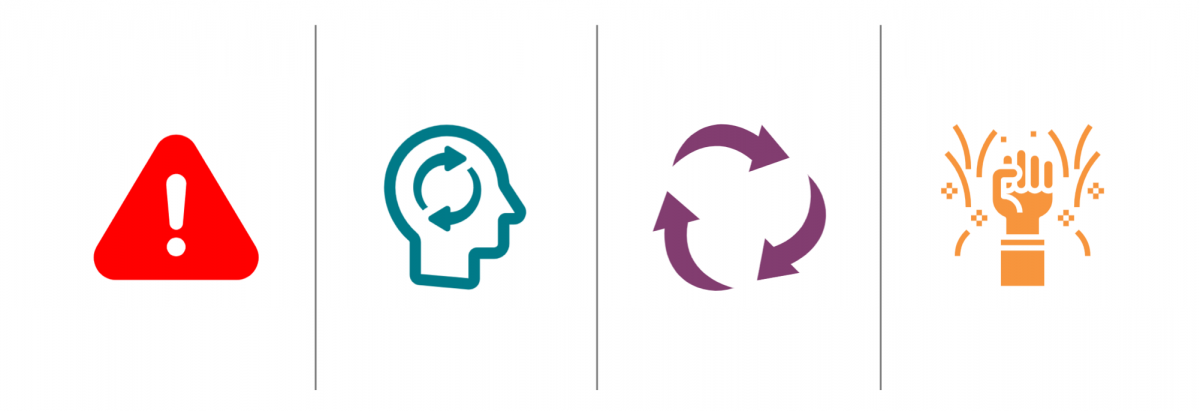Introduction
Social learning theory (SLT) shines a light on how we start to learn as children and continue to learn into adulthood; we mimic and model the behaviour of others. Also, we are adept at modifying our behaviour for varying situations and within the different social groups we spend time within.
If we do learn from others and our environment; then who are your people learning from? What are they actually learning? What or who is influencing their behaviour?
What interests me is how organisations can leverage social learning for better organisational outcomes in their performance and culture.
In 2017 Thinking Focus was challenged by a global automotive manufacturer to help them to develop soft skills in their frontline manager population. They had several requirements: the solution needed to be flexible and run in short sessions to suit their operation; have minimal preparation time and use in-house skills; and it needed to be interactive, fun and without the formality of academic and theoretical references.
Our research into a possible solution led us to consider many options and it became clear that the modelling of behaviour and the effect that peers had on each other’s approach to work was a significant factor. This led to extensive market research and the creation of a solution that we called ‘What Would you Do?’ (WWYD).
WWYD has been carefully engineered with a blend of mechanisms that inspire behavioural change. It incorporates gamification to engage and motivate participants to get involved and stay engaged. It creates a psychologically safe space where participants can be vulnerable and feel comfortable openly sharing their experiences; both the good and not so good. A facilitator manages the discussion, to probe and ask questions (coach) and to help the group understand the thought processes behind the actions. It uses everyday situations (scenarios) to enable the safe exploration of implications and consequences, all in a group forum. Sessions conclude with reflection and public commitment to underpin micro-changes in behaviours.
WWYD is a learning solution that adopts the same fundamental attributes of social learning that we have all been naturally doing all our lives.
What is social learning theory?
Social learning is doing what we see, modelling our behaviours on the behaviour of others and our environment. We are like chameleons; able to adapt our behaviours in different social contexts. We learn this through observing the behaviours of others whether that be home or work, friendship, sport or social groups.
Our ability to develop and adopt new social behaviours, attitudes and emotional reactions comes from imitating the behaviours of our parents or peers. Social learning is based on the behaviour modelling theory, where people learn new things by observing others.
The psychologist Albert Bandura is Professor Emeritus of Social Science in Psychology at Stanford University. Bandura considers humans to be active information processors, able to think about the relationship between their behaviour and its consequences. Humans possess the ability to choose, to intervene without merely imitating the behaviour of others.
In the 1960s Bandura undertook a series of experiments to understand the effects of observational learning on children’s behaviour. His findings underpin his 1977 theory, where children learn social behaviour through the observation of others. Children draw their behaviours from a variety of sources: parents and family members, friends and teachers, even fictional characters. These behaviours are interchangeable between boys and girls; they are not limited by gender.
When children observe others, they encode (the way we store information) the behaviour. They may then reproduce that behaviour later. However, the likelihood of them later imitating the behaviour is influenced by several factors.
Children are influenced by people who they consider to be like themselves; this is a factor in them being more likely to imitate behaviour modelled by others of the same gender.
Children are also influenced by the reaction of the people around them. When they reproduce a specific behaviour, how they are rewarded or punished will affect their likelihood of repeating the behaviour. Reinforcement is an important factor in influencing behaviour; this can be positive or negative. Reinforcement can be internal; a feeling of warmth when you do something that makes you happy. Or externally, from the recognition of others. Significantly though, it usually leads to a change in a person’s behaviour.

Children also consider how others are treated before deciding to model their behaviour. If they see the person positively rewarded, they are more likely to model that behaviour. The opposite is also true; if they see an adverse reaction towards a person’s behaviour, they are unlikely to repeat it. A person learns by observing what happens to others (known as vicarious reinforcement).
Children are more likely to identify with a role model when they possess a quality they aspire to have. Identification is different from imitation; imitation usually involves copying a single behaviour. Identification, however, consists of the adoption of a number of behaviours, such as values, beliefs and attitudes of the person with whom they identify.
How does SLT work?
SLT is considered by many as the bridge between traditional learning theory (behaviourism) and the cognitive approach. SLT focuses on how mental (cognitive) factors are involved in learning.
While Bandura agreed that classical conditioning (think Pavlov and his dogs) and operant conditioning (learning through reward and punishment) impact learning greatly, he also contributed two other ideas; mediating processes occur between stimuli and responses, and behaviour influenced by the environment through the process of observation.
Mediating processes are the cognitive intervention, where observed behaviour is not routinely followed but where cognitive reasoning takes place. In other words, our imitation of behaviour is not automatic. This mental evaluation takes place between the observed behaviour (the stimulus) and the decision to copy (the response) or not.
Bandura proposed four mediational process:

- Attention: The extent to which we notice or are exposed to the behaviour. We are exposed to many behaviours each day, and many don’t even register and therefore pass us by.
- Retention: Our ability to recall a behaviour. We need to form a memory of the behaviour to perform it a later time.
- Reproduction: Our capability to perform the behaviour as it was modelled to us. Our ability to reproduce is not always possible, for example if we are limited by our physiology.
- Motivation: Does performing the behaviour even register, in terms of importance? What rewards or punishments exist; do we consider it worth the effort?
WWYD was designed to meet all four mediational processes
Attention is captured in several ways:
• The format is group discussion – peers share experiences related to the debate.
• Scenarios are contextualised to the participant’s role- they are practical and not theoretical, presenting situations people can relate to.
• There is progress and jeopardy, which increases involvement. Tuning out, even briefly, could have consequences with a missed opportunity to score points or lose out entirely on the meaning of the discussion.
• Scenarios are set up to encourage debate; some have the added pressure of time constraints. An ‘against-the-clock’ feature causes cognitive conflict, self-doubt and the possible consequence of being frozen out of the round.
• The scoring range includes minus points – creating further jeopardy which increases concentration and engagement.
Strategies for retention:
• The socialising of experiences means that participants can use another’s experience to help prepare themselves for the model behaviour. They can learn from what their colleagues did well and where they struggled. Participants can also ask questions to develop their understanding further.
• The everyday situations are explored through debate. Participants test and probe ‘what if’ situations, their assumptions and biases and the implications of a course of action; as well as exploring what unintended consequences there might be.
• Each scenario offers up four options which are deliberately designed to be ‘imperfect’. This ambiguity causes cognitive conflict with the participant having to justify their choice.
Building capability for reproduction:
• Each scenario debated is concluded with a reflection step. Reflection is where the participants connect to the outcomes of the discussion. There is a debrief where participants determine what the desired behaviour should be. They are coached as a group by the facilitator, to consider the model behaviour for their organisation. The group decide what is and isn’t acceptable through reasoned argument.
Motivation: inspiration to learn and apply new behaviours
• The inclusion of gamification techniques both engages players to actively participate and it motivates them to stay the course. While scoring points is a factor, their main purpose is to keep participants focused and attentive. ‘FOMO’ (fear of missing out) and the friendly competition makes for a high energy session.
• At the end of each WWYD session, participants are invited to personally reflect on what they have learnt, sharing any realisations they may have had.
• Each participant is invited to publicly commit to one change in their behaviour in front of their peers. This public commitment is a psychological connection, a cognitive reinforcement which increases the likelihood of follow-through.
Seven reasons why you should be more interested in SLT.
- It’s already happening within your organisation. Understanding how it is benefiting you will unlock best practice and result in wider shared knowledge.
- Find out where it might be working against you. Typical indicators of issues to be resolved can be: culture, productivity, engagement, poor adherence to policy and processes. Who do you want your people modelling – are you leaving it to chance?
- Test the understanding of your internal communications. How effectively is your message getting through? SLT can help to ensure the message you intended has landed, by involving your people in the dissemination process.
- Your people can collectively decide the ‘right’ way. Build consistency through shared discussion, debate and exploration.
- Develop a broader understanding, by sharing perspectives across the organisation. Help your people improve their decision-making, with a greater appreciation for the ‘system’ and how it works. As a result, you become more efficient and effective.
- Unlock tacit knowledge. Every organisation is flush with unwritten rules and processes, undocumented knowledge that allows the ‘system’ to work. Socialising the learning across everyday situations will surface these valuable yet hidden practices.
- Surface key issues. Organisational politics has a devastating impact on productivity and efficiency. Socialising learning cross-functionally in a safe environment can bring the problems into focus and will encourage your people to own and solve the issues.
There are benefits for your people too.
- They learn that they are not alone; they realise that issues and challenges are more common, in other areas of the business – not just theirs.
- They build internal networks and support mechanisms which helps them to solve problems quicker and collaborate more effectively.
- Their mental wellbeing improves with an outlet to vent, share and gain perspective.
What does it look like in practical terms?
Understanding the principles behind social learning is one thing; bringing it to life is entirely another. How leaders behave is crucial; your people are looking to you.

How you behave when things go wrong will set the tone. Because people learn through observation, employees will look at how you behave in every situation, and they will make a judgement. They are considering if your behaviour is what they want to copy, measuring it against their own values. How your behaviour makes them, or others, feel will impact their decision too. Your people will evaluate how others react and decide whether to model your behaviour or not. The challenge is that you, as a leader, are not in control of their thought process, or how they choose to interpret what they see. This means authenticity is vital, and the need to be a role-model is more important than perhaps any of us thought.
So, what could you do?
Build social learning into your meetings; allow for an opportunity to review your work with three questions:
• What have we learned?
• What should we be doing more of and why?
• What is stopping us from being the best we can be?

Consider how you make your sessions feel safe. Allow people to speak their minds and express their opinions – it clears the way to the problem-solving. It doesn’t matter whether you choose to run sessions face-to-face or online. Create a forum for the group to be open and to share. Invite people to commit to an action – a new, better way of doing something.
Coaching is a proven tool for developing people one-to-one. What if you could group coach? Imagine a one-to-many facilitated discussion with purpose. You could solve common problems, build soft skills through discussion of contextual situations and share experiences to develop a shared vision of what ‘good’ looks like.
Build social learning into your training interventions
Reinforcement is an essential factor for influencing behaviour. Consider what are you reinforcing, knowingly and unknowingly. Are you proactive in celebrating when people model the desired behaviours? No reaction at all can leave people unsure if they are doing the right thing. Positive feedback helps to reinforce behaviours. Similarly, when behaviours are below the expected standard, challenge and coach people to understand why the standard exists and the implications of falling below.
And I did say, coach, not tell! Coaching takes time; time you may feel you don’t have – but it will have longer-lasting effects. ‘Tell’ is just a reprimand, and we all know this has limited impact and doesn’t last.
Some of your people will have aspirations to grow and develop. Think carefully about their mentor or internal role-models. We know that people are more likely to model the behaviour of others when they aspire to gain the knowledge, skill or attributes of the other person. Who do you want them to model?
The final way to build social learning into your development portfolio is through simulation and gamification. The trend towards the use of gamification has been growing. When you combine relevance, context and simulation, it really does bring social learning theory to life. The primary aim of any intervention is to create behaviour change, making things fun and exciting alone won’t cut it. Learners need to feel a sense of reward for the right behaviours or consequences for inappropriate ones. Gamification can add progress and jeopardy aligned to the desired outcomes. Decisions can be tested and explored in a safe space; participants can project the effects of certain behaviours and see how the implications would play out.
Conclusion
Social learning is how we naturally develop. As small children we learn through observation to mimic the values, beliefs and behaviours of others. Social norms also impact on which models we choose and whether to adopt new behaviours or not. This poses several questions for business leaders and learning professionals:
• Who are your people modelling their behaviours on?
• What values, beliefs and attitudes are they adopting?
• Who has the most influence on your culture?
• Are your people adopting your desired values, attitudes and behaviours?
• How are you, and your leaders, modelling the way?
• How do you control the narrative and the observation process?
If you are not already, you should be influencing the social learning experience. How you approach people who fall below your expected standards will have a significant impact on whether they choose to model the desired behaviour, or not. What consequences do they observe others face when they fail to live up to the values? What reward mechanisms exist when they do model the way?
Your people expect consistency; this is how they measure your commitment to your behavioural standards. Your people managers need to model the way; they need to hold others accountable and celebrate those who live up to the expected behaviours, values and attitudes. You cannot condone or accept poor behaviours just because of their perceived business performance. When you do this, you are telling your people that behaviours don’t matter, they are now a weapon to use to engineer the outcomes you really want.
Challenge your people to own the issues but consider how you go about it. You must be prepared to equip and empower them properly.
For clarity, equipping means that people are given the tools to think and plan effectively, the targeted development they need, the resources they need to execute and access to decision makers to ensure that effort is not duplicated and plans and actions are aligned.
True empowerment means giving people the autonomy and permission to go fix things. Experience suggests that whenever leaders ‘pretend’ to empower, they don’t fully let go and, when they inevitably intervene, impose or cast judgement, it almost always ends in tears.
Your people are already modelling the behaviours of others. They are constantly making choices about which behaviours to follow. Remember that their motivation might not be primarily concerned with what is right for the organisation. Their choices might be for social cohesion and the benefit of the social group. They may not want to stray away from existing group norms for fear of being outcast, driven by the fear of not belonging.
Are you prepared to leave the values, behaviours and attitudes you want to see in your organisation to chance?

